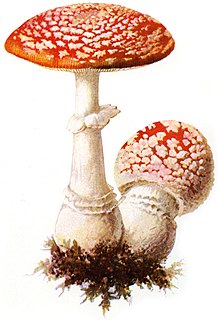
The genus Amanita contains about 600 species of agarics, including some of the most toxic known mushrooms found worldwide, as well as some well-regarded edible species. This genus is responsible for approximately 95% of the fatalities resulting from mushroom poisoning, with the death cap accounting for about 50% on its own. The most potent toxin present in these mushrooms is α-amanitin.

In mycology, a universal veil is a temporary membranous tissue that fully envelops immature fruiting bodies of certain gilled mushrooms. The developing Caesar's mushroom, for example, which may resemble a small white sphere at this point, is protected by this structure. The veil will eventually rupture and disintegrate by the force of the expanding and maturing mushroom, but will usually leave evidence of its former shape with remnants. These remnants include the volva, or cup-like structure at the base of the stipe, and patches or "warts" on top of the cap. This macrofeature is useful in wild mushroom identification because it is an easily observed, taxonomically significant feature. It is a character present among species of basidiomycete fungi belonging to the genera Amanita and Volvariella. This has particular importance due to the disproportionately high number of potentially lethal species contained within the former genus.
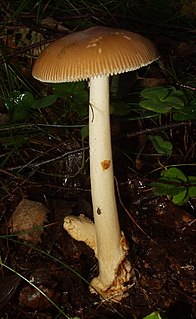
Amanita fulva, commonly called the tawny grisette or the orange-brown ringless amanita, is a basidiomycete mushroom of the genus Amanita. It is found frequently in deciduous and coniferous forests of Europe, and possibly North America.
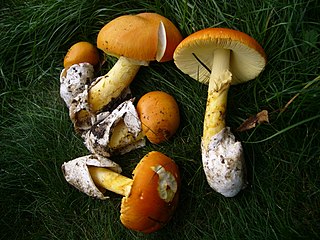
Amanita caesarea, commonly known as Caesar's mushroom, is a highly regarded edible mushroom in the genus Amanita, native to southern Europe and North Africa. While it was first described by Giovanni Antonio Scopoli in 1772, this mushroom was a known favorite of early rulers of the Roman Empire.

The vermilion grisette, also known as pretty grisette or vermilion amanita is a colourful mushroom of the genus Amanita. However, although it is often referred to by the common name "grisette", it is not closely related to other edible species that carry this common name, such as Amanita vaginata and Amanita fulva. It belongs to the same group of Amanita as A. muscaria and is reported to be toxic.

Amanita calyptroderma also known as coccora, coccoli or the Pacific amanita, is a white-spored mushroom that fruits naturally in the coastal forests of the western United States during the fall and winter and spring.
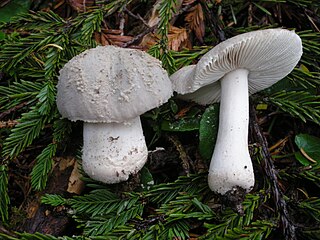
Amanita farinosa, commonly known as the Eastern American floury amanita or the American floury amanita, is a North American poisonous mushroom of the genus Amanita, a genus of fungi including some of the most deadly mushrooms.

Amanita verna, commonly known as the fool's mushroom, destroying angel or the mushroom fool, is a deadly poisonous basidiomycete fungus, one of many in the genus Amanita. Occurring in Europe in spring, A. verna associates with various deciduous and coniferous trees. The caps, stipes and gills are all white in colour.
Amanita orientifulva, also known as the Asian orange-brown ringless amanita, is a species of agaric fungus found at altitudes ranging from 1,300–4,200 m (4,300–13,800 ft) in southwestern China. It is associated with trees, especially Abies, Quercus, Salix, and occasionally Castanopsis. It fruits singly or scattered from June to September.

Amanita muscaria var. guessowii, commonly known as the American yellow fly agaric, is a basidiomycete fungus of the genus Amanita. It is one of several varieties of the Amanita muscaria fungi, all commonly known as fly agarics.

Amanita vaginata, commonly known as the grisette, is an edible mushroom in the fungus family Amanitaceae. Unlike many other Amanita mushrooms, A. vaginata lacks a ring on the stem. The cap is gray or brownish, 5 to 10 centimetres in diameter, and has furrows around the edge that duplicate the gill pattern underneath. It has a widespread distribution in North America, and is thought to be part of a species complex that includes other similar-looking Amanitas.

Amanita jacksonii, also known as Jackson's slender amanita, is a species of fungus in the family Amanitaceae. It is a reddish-orange colored mushroom species extending from the Province of Quebec, Canada to at least the State of Hidalgo, Mexico. It was given its current name in 1984 by Canadian mycologist René Pomerleau. It can be identified by its yellow gills, large, white, sacklike volva, and bright orange or orange red cap, which has lined margins.

Amanita atkinsoniana, also known as the Atkinson's amanita, is a species of fungus in the family Amanitaceae. It is found in the northeastern, southeastern, and southern United States as well as southern Canada, where it grows solitarily or in small groups on the ground in mixed woods. The fruit body is white to brownish, with caps that measure up to 12.5 cm (5 in) in diameter, and stems up to 20 cm long and 2.5 cm (1 in) thick. The surface of the cap is covered with reddish-brown to grayish-brown conical warts. The stem has a bulbous base covered with grayish-brown scales. The fruit bodies smell faintly like bleaching powder. Although not known to be poisonous, the mushroom is not recommended for consumption.
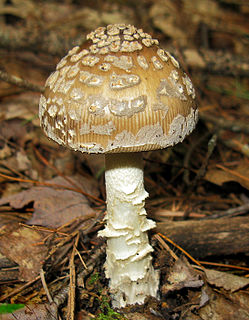
Amanita ceciliae, commonly called snakeskin grisette, strangulated amanita, and the Cecilia's ringless amanita, is a basidiomycete fungus in the genus Amanita. First described in 1854 by Miles Joseph Berkeley and Christopher Edmund Broome, it was given its current name by Cornelis Bas in 1984. It is characterized by bearing a large fruit body with a brown cap 5–12 cm (2.0–4.7 in) across. The cap has charcoal-grey patches, which are easily removable. The stipe is 7–18 cm (2.8–7.1 in) long, white in colour, and there is no ring on it. It is slightly tapered to the top, and has irregular cottony bands girdling the base. The universal veil is grey. Spores are white, spherical in shape, non-amyloid, and measure 10.2–11.7 micrometres. The mushrooms are considered edible, but field guides typically advise caution in selecting them for consumption, due to risks of confusion with similar toxic species. A. ceciliae is found in woods throughout Europe and North America, where it fruits during summer and autumn.

Amanita albocreata, also called the ringless panther or the ringless panther amanita, is a species of fungus in the family Amanitaceae. It is commonly found in northeastern United States and southeastern Canada and elsewhere in North America. This species, that grows about 5 to 15 centimeters in length, is doubted to be fatally toxic. It normally grows between the rainy months of June and August.

Amanita parcivolvata also known as ringless false fly amanita, is a fungus that produces fruit bodies that vaguely resemble those of Amanita muscaria. It is differentiated, however, by its lack of an annulus, by the volval deposits on its stipe/base, and by its pileal striations. It occasionally lacks a stipe bulb entirely, instead just tapering to a point in the ground with powdery volval deposits on its surface. It ranges from 3–12 cm (1.2–4.7 in) in length and is occasional to common in the Southeastern United States, occurring primarily in Quercus forests though it has been observed in forests with a mix of conifers and oaks.

Amanita pachycolea, commonly known as the western grisette or the Stuntz's great ringless amanita, is a species of agaric fungus in the family Amanitaceae. It was recognized as a distinct species by mycologist Daniel Elliot Stuntz, and published in 1982 by Harry Delbert Thiers. Found in western North America, it associates with conifers in coniferous and mixed forests. Amanita pachycolea is classified in Amanita section Vaginatae, which includes species with conspicuous radial striations on the cap, inamyloid spores, and the absence of a ring on the stipe. The mushroom is edible, but not recommended due to possible confusion with toxic Amanita species.

Amanita sinicoflava, the mandarin yellow ringless amanita, is an inedible species of fungus in the large genus Amanita. Found in North America, the fungus was described as new to science in 1998 by mycologist Rodham Tulloss. The type collections were made in Sussex County, New Jersey. The mushroom grows in sandy soil under Quercus, Pinus rigida, Acer rubrum, Quercus alba, and Quercus velutina. Fruitbodies have yellow-olivaceous or olive-tan caps that measure 2.5–7 cm (1.0–2.8 in) in diameter. There are grooves on the cap margin that extend about 40% of the distance from the margin to the apex. The spores are spherical or nearly so, typically measuring 9.1 to 12.2 micrometres by 8.4 to 11.5 micrometres. The white stipe is ornamented with slightly darker fibrils, and there are sac-like remnants of the volva at the stipe base. The specific epithet sinicoflava means "Chinese-yellow", referring to the cap color.

Amanita spreta is an inedible species of the genus Amanita.























